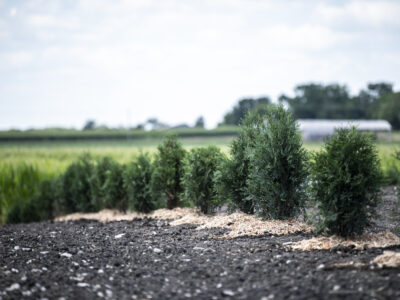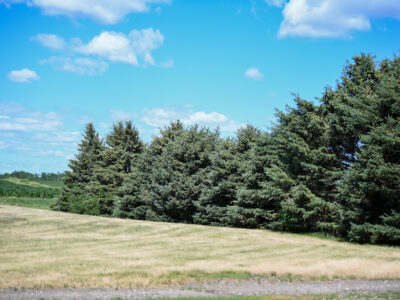Farmer Finds New Passion in Trees
08-17-2021 in Green Farmstead Partner
Rembrandt farmer works with CSIF to grow his tree dreams
Trent Hatlen grew up with hogs. His parents raised them. He raised them.
Then, in 2010, with a weak swine market and aging facilities, he reluctantly decided to get out of the hog business. He kept farming corn and beans, worked sheep with a cousin, did a little trucking and odd jobs, but something was missing.
It was 2017 when his banker mentioned Iowa Select Farms was looking for producers in the area and suggested it might be an opportunity for him to return to the hog business. If interested, he was told he should start with the Coalition to Support Iowa’s Farmers (CSIF).
Hatlen expected advice and expertise. What he didn’t expect was a new passion in life – trees.
“I just love trees,” says Hatlen.
CSIF staff met with Hatlen, providing tips on siting the new barn, sharing expectations, guiding him through his manure management plan, and providing insight into neighbor relations. They reviewed the site and created a plan. Then they introduced him to their Green Farmstead Partner Program.
The Green Farmstead Partner Program is a unique initiative that provides guidance to farmers who want to plant trees and shrubs around their livestock buildings. Iowa State University research shows trees near a livestock site can reduce odor by 10-15 percent by capturing dust and odor particles and directing airflow. A vegetative buffer also offers real benefits in the form of energy cost savings, weather protection, improved building ventilation and in some cases, even provides an additional revenue stream.
Hatlen was in. He saw a farm site surrounded by trees and he wanted it.
“Things snowballed from there,” says Hatlen.
He contacted Kelly Tree Farm to help design a windbreak. He worked with the local NRCS on a cost share option.
 The dream becomes reality
The dream becomes reality
Hatlen erected two attached hog barns, each with 2,400 head capacity. His seventh batch of 10-15 lb. pigs just went in.
The windbreak is growing.
They planted 300 Techny Arborvitae to form the exterior barrier; the middle row is Norway Spruce; White Pines line the inside, along with a row of dogwood.
Aside from the practical aspects of the windbreak, it offers an aesthetic element to the site, along with two acres of wildflowers.
“We have a lot of butterflies,” says Hatlen, who adds the neighbors think it is gorgeous with new visuals every week. “The wildflowers were easy to establish. I just had to keep it mowed the first year.”
Now, two years later, the Norway Spruce are now 4 to 5 feet tall, growing about a foot a year. He already notices a marked difference in the power of the northwest wind.
“They say give them a few years to get their shape,” says Hatlen. “They stop some snow now, in another 5 years, they’ll stop a lot of snow.”
Hatlen isn’t done.
He’s planted another windbreak west of his house, replacing the Colorado Firs his parents planted years ago. “They were the tree to plant 25 years ago,” says Hatlen. “But now they have a fungus.”
He learned at a CSIF Green Farmstead Partner Program conference that a variety of trees is preferable. West Virginia firs, Siberian Spruce, Red Oak, Hackberry – are all either on his place or on his radar.
“I’m looking forward,” he says. At age 45, he’s starting to think of his tree legacy.
He ordered 50 Shagbark Hickory bulbs and distributed them around the neighborhood. “Near here, there is a 7 mile stretch of gravel road lined by Ponderosa Pines. They were planted by 2 sisters 70 to 80 years ago,” says Hatlen. “Someday someone will say the Shagbark Hickories in the area were planted by that guy who loved trees.”
He became enamored of the species when he saw them in Sac City, but they are difficult to transplant. “The first effort didn’t go so well,” he says, “but they should survive here.” He’s researched, studied and ordered nuts from a grower near Runnells.
Looking ahead
Hatlen encourages young farmers to jump on board. “I hear these young people, 25 and 30-year-olds, and they’re starting to do tree projects. It makes me happy, but more is always better,” he said with a smile. Hatlen noted the younger folks are often shocked at the price of a windbreak, expecting a price tag upwards of $20,000, instead of the more average $4,000 – $5,000.
“Trees are not that expensive,” says Hatlen, “especially when you look at the long-term benefits.”
Hatlen is thinking long-term. His daughter, now age 19, is part of the plan. “I want her to make her own decisions about her future, but I know she’ll always be a part of the farm in some way.”
The prospect of her taking on the operation was a factor in adding the hogs – a decision Hatlen says was one of the best decisions he ever made.
He may add more hogs. He may add more acres. He will definitely add more trees.
He’s working on planting Larchwoods in a spot across the road.
The Coalition to Support Iowa’s Farmers was created by farmers to help farmers raise livestock successfully and responsibly. It’s a partnership involving the Iowa Beef Industry Council, Iowa Cattlemen’s Association, Iowa Corn Growers Association, Iowa Farm Bureau Federation, Iowa Pork Producers Association, Iowa Poultry Association, Iowa Soybean Association, Iowa Turkey Federation and Midwest Dairy. The non-profit, non-partisan organization aids farmers at no cost. CSIF does not lobby or develop policy. Farm families wanting a helping hand can contact the coalition at supportfarmers.com or 800.932.2436.
(By Terri Queck-Matzie for CSIF. Queck-Matzie is a freelance writer from Greenfield).
-30-
Recommended News

Green Farmstead Partner Program Supports Boone County Family in Adopting Sustainable Practices
Rod and Missy Bice of Boone County have sought guidance from the Coalition to Support Iowa's Farmers (CSIF) for help with rules and regulations regarding their livestock farm, Golden Circle...
Read More
Growing the Ag Environment
Ryan and Lana Reed of Wapello County spent an almost-spring-like March day tending to the windbreak near two of their hog barns. Planted in 2010, the fast-growing austree hybrid willow...
Read More
Ames Landscaper Joins Green Farmstead Partner Program
West Des Moines, Iowa – April 4, 2023 — Landscape Legends of Ames has been designated a participating landscape professional in the Coalition to Support Iowa’s Farmers’ (CSIF) Green Farmstead...
Read More